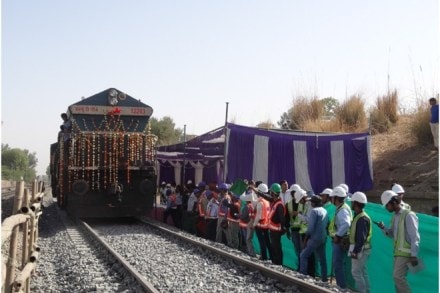Indian Railways recently took a big step forward towards achieving its aim of commissioning dedicated freight corridors on its network. The Dedicated Freight Corridor Corporation of India Ltd (DFCCIL) recently carried out the first trial run of an Indian Railways locomotive on the Ateli-Phulera section of the Western Dedicated Freight Corridor. The locomotive achieved the maximum speed of 100 kmph on the 190 km stretch and covered it in 3 hours and 52 minutes. According to a DFCCIL official, the Western Dedicated Freight Corridor will be commissioned in 2020. “A lot of progress has been made on the ambitious project, around 500 km of track has already been laid and trials of locomotives will continue as and when more stretches get ready,” the official told FE Online. With the commissioning of the dedicated freight corridors, Indian Railways is hopeful of increasing the average speed of freight trains from 26 kmph to 70 kmph – a step that will be a big game-changer for the network.
Western Dedicated Freight Corridor: Why the locomotive trial and the project are important
According to Harsh Shrivastava of Feedback Infra the successful trial of the locomotive at speeds of 100 kmph is a significant milestone and gives hope that the DFC will be commissioned on time. “For a project of this scale, there are multiple benefits and learnings,” he told FE Online. “DFCs are about capacity augmentation, they are about faster movement of freight and about learnings from a project of this scale,” Shrivastava added talking about the significance of the project and the trial.
Shri Prakash, Former Railway Board Member told FE Online that the dedicated freight corridor projects were envisaged in 2006 to provide impetus to economic growth and enable better traffic movement on key routes – eastern and western. “It’s been several years since then but the projects are still as relevant. I believe that the pace of track laying and overall project execution has picked up now and the deadlines of 2019 and 2020 look achievable,” he said. “Dedicated freight corridors will help in faster movement of goods and also create better capacity on existing lines hence allowing speedier movement of passenger trains,” he elaborated adding that the key to the projects’ success ultimately lies in providing a robust feeder network to consumers.
Watch now! Trial run of locomotive at 100km/per hour on DFC track
Modern locomotives:
Indian Railways’ two big FDI projects involve manufacturing world-class locomotives under government’s ‘Make in India’ initiative. While GE will be manufacturing diesel electric locomotives of 4,500 and 6,000 HP at its factory in Bihar’s Marhowra, Alstom is making 12,000 HP electric locomotives at its Madhepura plant. These locomotives are expected to drive freight trains on both Eastern and Western Dedicated Freight Corridors.
Alain Spohr, Managing Director, India & South Asia for Alstom believes that better infrastructure will bring “fluidity in the Indian Railways network which might ultimately turn freight movement into a sustainable, profit-making enterprise for the railways.” “Freight trains plying on the mainline network have been known to eat into the capacity of passenger movement and cause delays in freight deliveries. Scheduling, especially during climactic impediments and mishaps has been a matter of great complexity when the network is shared between freight and passenger movement. With dedicated freight corridors, these two immediate problems will have easier solutions,” Spohr told FE Online. “Passenger capacity of the mainline improves with room to introduce high speed trains, while freight networks benefit from seamless shuttle. Deploying faster locomotives with better efficiency ratios and lower life-cycle costs will not just increase the annual output of freight moved, but will help plug financial leak that is maintenance of these locomotives,” he added.
Watch: Indian Railways converts diesel loco to electric locomotive
Nalin Jain, President – International business, GE Transportation is of the view that “freight trains need ability to pull large loads and many wagons while passenger trains need ability to run at high speeds and quick acceleration.” “Due to the difference in fundamental capability expectations, passenger and freight locomotives and their propulsion systems / power plants are designed differently,” he told FE Online talking about the importance of modern locomotives.
The Western Dedicated Freight Corridor, when it is commissioned, will cover 1504 distance across the states of Uttar Pradesh, Haryana, Rajasthan, Gujarat and Maharashtra. Of this Rajasthan will have the largest kilometres of track at 567 km, followed by Gujarat with 565 km. While Haryana and Maharashtra will have 177 km of tracks, Uttar Pradesh will have 18 km.
